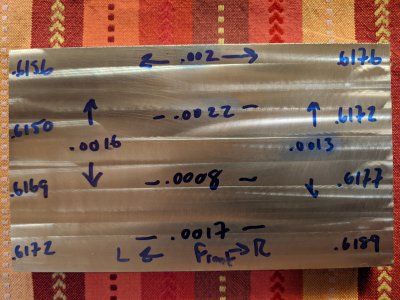- Joined
- May 9, 2020
- Messages
- 42
I have a new Grizzly G0619. I have been having fun with it and now that the fun is turning into an obsession, I am trying to figure out what I am doing wrong. So here's the story. I bought an Accusize 2" Facing tool with 3 cutters. When putting a block of aluminum in the vise, tapping it down on top of the parallels to make sure its sitting tight, I then run the facing tool down the X-Axis of the table. Doing essentially a half overlap I notice distinct lines running along the surface of the block. They have a discernable ridge about .0055 to .001. Also, after facing both sides of the block, I then measure it and it's out up to .002 longitudinally and about .0015 on the Y-Axis.
A little history on my obsession with this issue, I have put a dial indicator in the chuck and checked the table on both x and y axis. X is out less than .0005 across the length of the table. Y is almost perfect, less than .0005. The vise is out about .001 on the X- Axis and less than that on the y-axis. Its a big ole 6 inch vise that weighs about 40 lbs I would guess.
So, the photo is using a 3/4 HSS TIN end mill, NOT the facing tool. I faced the other side to get it as flat as possible on the Y-axis to see if the ridges went away and they did. The side you are looking at is the orientation that is was in in the mill. I forgot to lock the Z-Axis down until I got just past the .6150 mark. You can see the swirls where is changed the depth a little.
I am wondering how I can rectify these weird differences in the facing. Any help is much appreciated.
A little history on my obsession with this issue, I have put a dial indicator in the chuck and checked the table on both x and y axis. X is out less than .0005 across the length of the table. Y is almost perfect, less than .0005. The vise is out about .001 on the X- Axis and less than that on the y-axis. Its a big ole 6 inch vise that weighs about 40 lbs I would guess.
So, the photo is using a 3/4 HSS TIN end mill, NOT the facing tool. I faced the other side to get it as flat as possible on the Y-axis to see if the ridges went away and they did. The side you are looking at is the orientation that is was in in the mill. I forgot to lock the Z-Axis down until I got just past the .6150 mark. You can see the swirls where is changed the depth a little.
I am wondering how I can rectify these weird differences in the facing. Any help is much appreciated.



